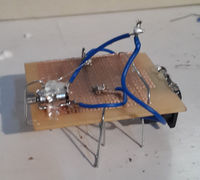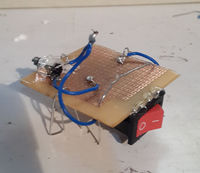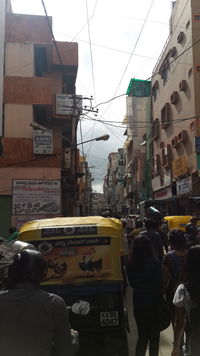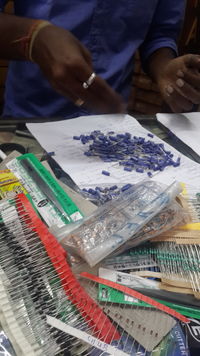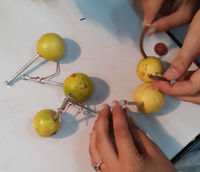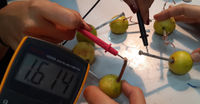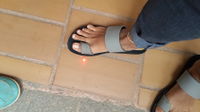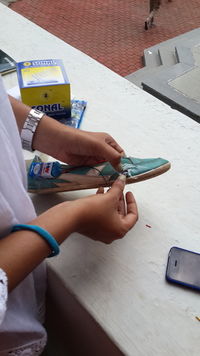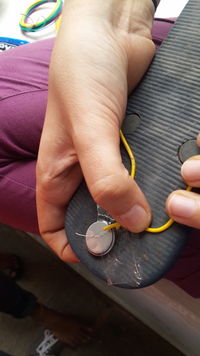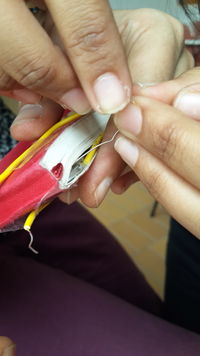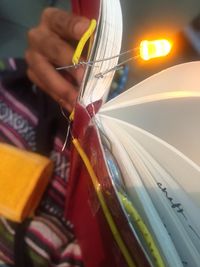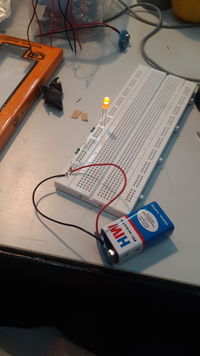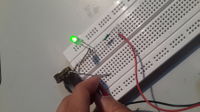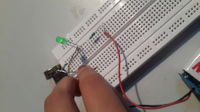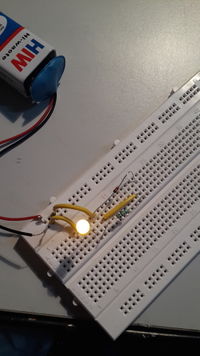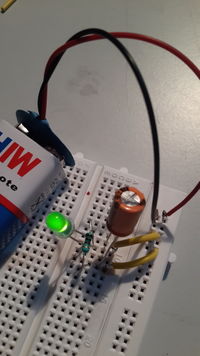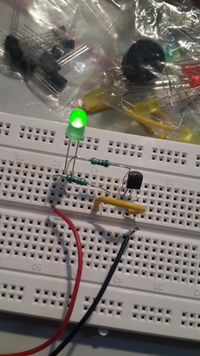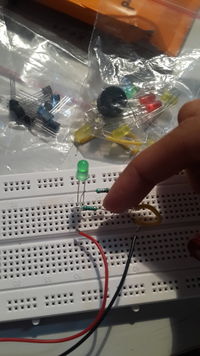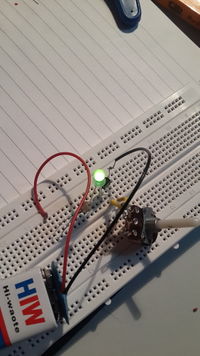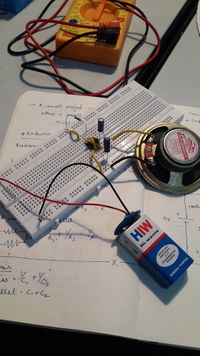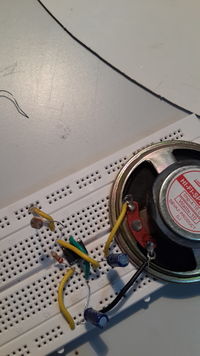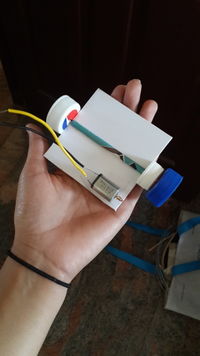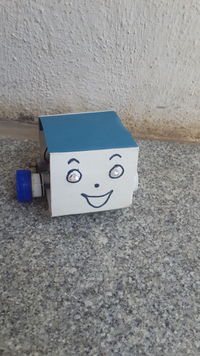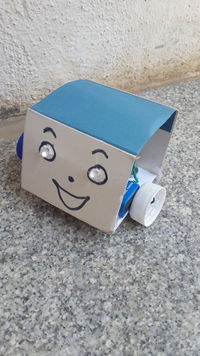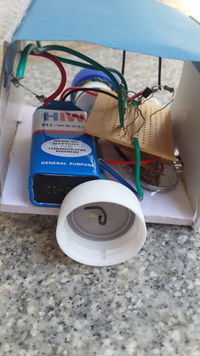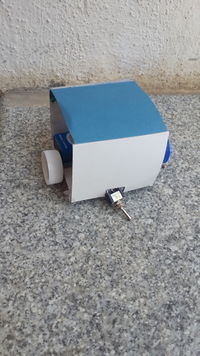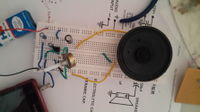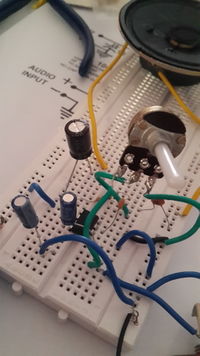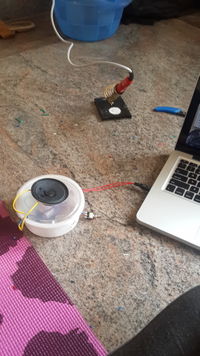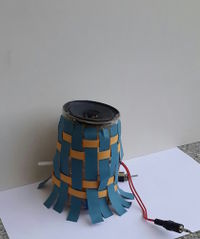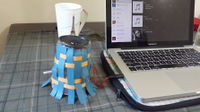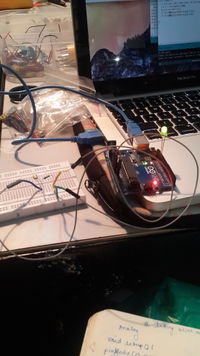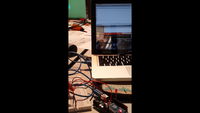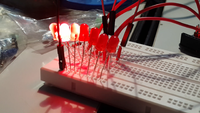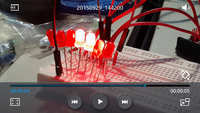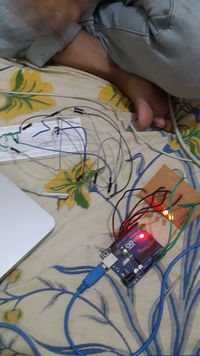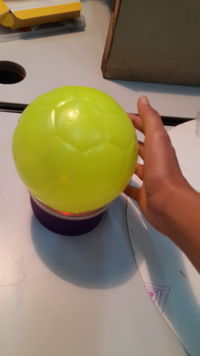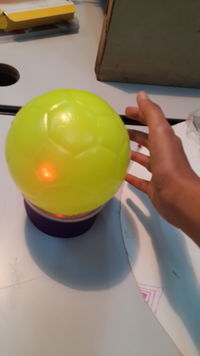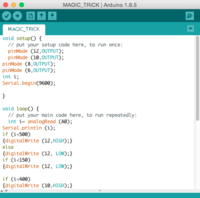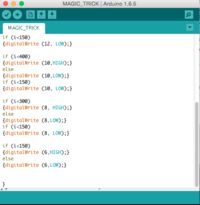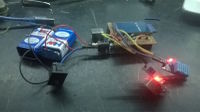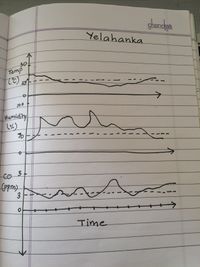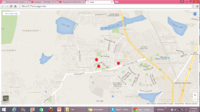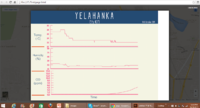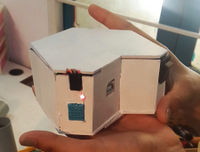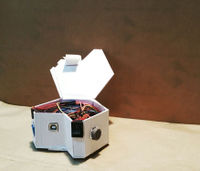Difference between revisions of "Prarthana"
(→Trip to SP road) |
(→Magic instrument) |
||
| (50 intermediate revisions by one user not shown) | |||
| Line 2: | Line 2: | ||
=='''Micro Robots'''== | =='''Micro Robots'''== | ||
Introductory class | Introductory class | ||
| − | |||
| − | |||
| − | |||
| − | |||
[[File:Robot 2.jpg|left|200px|Micro Robot]] | [[File:Robot 2.jpg|left|200px|Micro Robot]] | ||
| − | [[File:Robot 3.jpg|right|200px|Micro | + | [[File:Robot 3.jpg|right|200px|Micro Robot 2]] |
Building my own Robot on the very first day kick- started my interest in electronics. Not only did we learn how to build a basic circuit but also how to solder. Soldering makes your work look much neater and also adds the basic strength required within the different components of a circuit. What boosted my learning was the fact that we did all of this practically with minimal theory. I believe that what you learn practically by experimenting is far more effective and deeper than what you learn merely through theory. | Building my own Robot on the very first day kick- started my interest in electronics. Not only did we learn how to build a basic circuit but also how to solder. Soldering makes your work look much neater and also adds the basic strength required within the different components of a circuit. What boosted my learning was the fact that we did all of this practically with minimal theory. I believe that what you learn practically by experimenting is far more effective and deeper than what you learn merely through theory. | ||
| Line 18: | Line 14: | ||
==[[Trip to SP road]]== | ==[[Trip to SP road]]== | ||
| + | |||
| + | [[File:SP 1.jpg|left|200px|SP road]] | ||
| + | [[File:SP 2.jpg|right|200px|Vishaal electronics]] | ||
It was a very tiring day, but going to this hub of electrical supplies was worth all the physical and mental exhaustion. It was interesting how the entire lane consisted of electrical shops, some big some small. I wondered how the market worked with competition all around you. Why would you place all these electrical stores right next to each other, where you get more or less the same things. But when we went around a couple of stores asking for the list of things we needed, we realized that all these shops had some sort of a healthy tie-up. We went to a couple of stores, where they didn’t have all the materials on the list, instead of asking us to buy whatever they had, they suggested different stores where we would find all the things at one stop. So all of them helped each other out to ensure a collective sale. This was also portrayed when, at Vishaal electronics, they bought the things that they didn’t have, and were on our list, from the neighboring stores. | It was a very tiring day, but going to this hub of electrical supplies was worth all the physical and mental exhaustion. It was interesting how the entire lane consisted of electrical shops, some big some small. I wondered how the market worked with competition all around you. Why would you place all these electrical stores right next to each other, where you get more or less the same things. But when we went around a couple of stores asking for the list of things we needed, we realized that all these shops had some sort of a healthy tie-up. We went to a couple of stores, where they didn’t have all the materials on the list, instead of asking us to buy whatever they had, they suggested different stores where we would find all the things at one stop. So all of them helped each other out to ensure a collective sale. This was also portrayed when, at Vishaal electronics, they bought the things that they didn’t have, and were on our list, from the neighboring stores. | ||
| Line 30: | Line 29: | ||
The fact that, despite doing so much, the LED didn’t light up, was disappointing. However, the battery was functional, as measured by the Multimeter. During the process one of the major difficulties faced was finding the materials. Copper wires were easily available, but we needed a source of zinc. We asked around for galvanized nails for the same, but the shopkeepers didn’t have that knowledge themselves (whether the nails that they sold were galvanized). After looking around at all the possible places, we landed up on one of the hardware stores in Yelahanka New Town where they did possess galvanized nails. Overall, the project was accomplished as we did make the battery which was functional, however it wasn’t demonstrated properly by lighting up an LED. | The fact that, despite doing so much, the LED didn’t light up, was disappointing. However, the battery was functional, as measured by the Multimeter. During the process one of the major difficulties faced was finding the materials. Copper wires were easily available, but we needed a source of zinc. We asked around for galvanized nails for the same, but the shopkeepers didn’t have that knowledge themselves (whether the nails that they sold were galvanized). After looking around at all the possible places, we landed up on one of the hardware stores in Yelahanka New Town where they did possess galvanized nails. Overall, the project was accomplished as we did make the battery which was functional, however it wasn’t demonstrated properly by lighting up an LED. | ||
| + | |||
| + | [[File:Lemon battery 1.jpg|200px]] | ||
| + | [[File:Lemon battery reading.jpg|200px]] | ||
===Switch=== | ===Switch=== | ||
| Line 35: | Line 37: | ||
The task at hand was to make a crazy switch. Any crazy action, movement or anything that would act as a switch for either an LED to light up or a buzzer to start buzzing. As a group we brainstormed a lot and came up with four different ideas for the same. Three of the crazy switches were initiated by pressure whereas one of them was initiated by touch. One of the ideas was that an LED, attached to a flip flop, would light up as you walk. We used two different structures for that. In one, we attached an LED directly to a coin battery; in such a way that one of the legs was attached to a side, however the other would only touch as you walk. For the other flip flop, we used wires, concealed them in the design, which connected the battery to the LED. In yet another design we connected a battery in a similar fashion to a buzzer, which would cause it to buzz as a person walked. However, in this case we couldn’t use a coin battery because a buzzer required more voltage. So we had to somehow fit the 9V battery into a shoe, in a way that it is concealed, and hence build a circuit around it. The fourth switch was such that an LED would light up as you open a book. The LED in this case was placed over the book, in such a way that if it was more powerful, it would provide enough light for reading. This was a flimsy switch as we solely had to depend on the bare wires, placed on either side of the book to touch as the book opened. Hence, we had to adjust the wires in a particular position before we could demonstrate this. I would like to work further on this idea, and find a way to make the structure more concrete and durable. | The task at hand was to make a crazy switch. Any crazy action, movement or anything that would act as a switch for either an LED to light up or a buzzer to start buzzing. As a group we brainstormed a lot and came up with four different ideas for the same. Three of the crazy switches were initiated by pressure whereas one of them was initiated by touch. One of the ideas was that an LED, attached to a flip flop, would light up as you walk. We used two different structures for that. In one, we attached an LED directly to a coin battery; in such a way that one of the legs was attached to a side, however the other would only touch as you walk. For the other flip flop, we used wires, concealed them in the design, which connected the battery to the LED. In yet another design we connected a battery in a similar fashion to a buzzer, which would cause it to buzz as a person walked. However, in this case we couldn’t use a coin battery because a buzzer required more voltage. So we had to somehow fit the 9V battery into a shoe, in a way that it is concealed, and hence build a circuit around it. The fourth switch was such that an LED would light up as you open a book. The LED in this case was placed over the book, in such a way that if it was more powerful, it would provide enough light for reading. This was a flimsy switch as we solely had to depend on the bare wires, placed on either side of the book to touch as the book opened. Hence, we had to adjust the wires in a particular position before we could demonstrate this. I would like to work further on this idea, and find a way to make the structure more concrete and durable. | ||
| + | |||
| + | [https://www.youtube.com/watch?v=tDg0AzLEGvo&feature=youtu.beI| Click here] to watch the video. | ||
| + | [https://www.youtube.com/watch?v=6D3G3wGButI&feature=youtu.beI| Click here] to watch second video. | ||
| + | |||
| + | |||
| + | [[File:Crazy switch 1.jpg|200px]] | ||
| + | [[File:Crazy switch 2.jpg|200px]] | ||
| + | [[File:Crazy switch 3.jpg|200px]] | ||
| + | [[File:Crazy switch 4.jpg|200px]] | ||
| + | [[File:IMG_3601.jpg|200px|Switch is On]] | ||
===Resistors=== | ===Resistors=== | ||
====Fixed Resistors==== | ====Fixed Resistors==== | ||
| + | |||
| + | One most important thing that we learned today was how to use a breadboard for prototyping your circuit. We just made a basic circuit with resistors on breadboard. At this point of time I didn’t realize the significance of it, I just saw it as another complication. But later, as we made more complicated circuits, which had to be soldered together, did I realize the importance of it. In the simple circuit made today, we used a 9V battery source to light up an LED or two. Before using the resistors, I just touched an LED’s legs directly to a 9V battery, like we did to test it with a 3V battery. It fused! That is when I understood why a resistor was needed, in order to reduce the voltage that the LED received. I experimented with attaching one and two 1K resistors with different numbers of LEDs. I noticed how, when 2 LEDs attached in the circuit, they become dim as I add another resistor to it. This is when all the theory learned back in school made some sense to me. All of these components were attached in series, and according to the theory learned, voltage gets divided between components attached in series, hence resulting in the dimness in the LEDs with the attachment of more resistors. | ||
| + | |||
| + | [[File:Fixed resistors.jpg|200px]] | ||
| + | |||
====Variable Resistors==== | ====Variable Resistors==== | ||
| − | |||
| − | |||
| − | |||
| − | ===Capacitors=== | + | Potentiometer, thermistor and LDR |
| − | == | + | |
| + | I had never seen, let alone worked with, any of these variable resistors. I was faintly familiar with these components; as per the class 12th physics theory. However, I never truly understood the purpose or the functionality of the same. After understanding a bit of theory and the schematic circuit diagrams, we started making the circuit on the breadboard. It seemed very complex to me at the moment because I was also struggling to understand the connections on the breadboard at that point, but I with better understanding of functioning of breadboard, the concept became completely clear. Potentiometer, when attached in a circuit with an LED and a battery, enabled me to control the dimness of the LED by just turning around a plastic shaft. As learned earlier I understood how it functioned; as the resistance becomes higher (by turning the shaft), the voltage received by the LED reduces, hence causing the dimness, and vice versa. We experimented similarly with LDR and thermistor. This is when I realized that all these components are not as scary or complicated as they sounded in text-books! I could already think about the countless possibilities about where these could be used or are being used. We all have used the potentiometer quite often, controlling the volume in speakers or television for example. Similarly there is a scope of building so many cool things using the variable resistors; thermistor and LDR. | ||
| + | |||
| + | [[File:Variable resistor 1.jpg|200px]] | ||
| + | [[File:Variable resistor 2.jpg|200px]] | ||
| + | |||
| + | ===Capacitors and Diodes=== | ||
| + | |||
| + | I never understood the concept of a diode, but while experimenting on breadboard and through theory I learned that it lets the current flow in one direction only. We tested with turning it around in the circuit, when the LED stopped glowing. We connected another wire from other end to where it met the circuit to once again change its direction and hence make the LED glow. A capacitor stores energy in it, which could be used later. This was demonstrated by making a simple circuit with it. We connected it in series with other basic circuit components and saw how the LED still glowed after taking out the battery. It only lasted till less than a second, probably because of the lower capacity of the capacitor used. I later experimented with different values of capacitors, each giving a different duration till which the LED stayed lit. Nonetheless, none of the capacitors I experimented with made the LED glow for more than 2s. | ||
| + | |||
| + | [https://www.youtube.com/watch?v=v5-37d8x5N0&feature=youtu.beI| Click here] to watch the video. | ||
| + | |||
| + | [[File:Diode 2.jpg|200px]] | ||
| + | [[File:Diode.jpg|200px]] | ||
| + | |||
===[[Transistors]]=== | ===[[Transistors]]=== | ||
| − | + | ||
| + | Initially when we made a circuit with transistor, using 22k and 1k resistance, I didn’t quite understand the use of it. Later after some theory and experimentation with LDR did I get to know about it’s amplifying qualities. It was interesting how, instead of one of the resistors we used our body resistance to complete the circuit! Never knew our body had resistance, which could be used in such a way. This idea could be used to make so many cool things, from magic trick toys to just fascinating products and objects. I remember, as a kid, I used to own a lamp, which would light up as you touch it. Now with knowledge of all these electrical components I’m starting to unravel my childhood magic items. | ||
| + | |||
| + | [https://www.youtube.com/watch?v=lMHZ-pIPoO8&feature=youtu.beI| Click here] to watch the video. | ||
| + | |||
| + | [[File:Transistor 1.jpg|200px]] | ||
| + | [[File:Transistor 2.jpg|200px]] | ||
| + | [[File:Transistor 3.jpg|200px]] | ||
==[[555 oscillator]]== | ==[[555 oscillator]]== | ||
| − | + | ||
| + | I had never seen an IC chip before, the entire idea of it seemed very complicated to me. As soon as I saw the circuit where 555 IC chip was used to make the 555IC oscillator, the entire concept seemed vague. This was especially because I was still trying to understand the function of breadboard properly. End of this class was when I completely understood how to use a breadboard and could hereafter use for any complicated circuit given. Making it was not as difficult as it seemed in the schematic diagram; had to take some help here and there but it did work at the end of the day and that is what kept my confidence boosted. After making the circuit on breadboard I experimented around with using LDR and thermistor instead of the 100k resister to get varied sounds according to the light and heat respectively. | ||
| + | |||
| + | [https://www.youtube.com/watch?v=Pk1WfrzQO9Y&feature=youtu.beI| Click here] to watch the video. | ||
| + | |||
| + | [[File:555 1.jpg|200px]] | ||
| + | [[File:555 2.jpg|200px]] | ||
| + | |||
| + | ==[[Project: Making a toy]]== | ||
| + | |||
| + | The task at hand was to make a toy using the electronics knowledge gathered in the class till now. I brainstormed a little and came up with 4 ideas from which I could choose. The first that I thought of was to make a toy car using a motor. I also thought of making a character whose hands (joints) would move, also using a motor. The third idea consisted of a monster head which would have LED’s as horns, which would double blink, something that I saw on a breadboard experiment online using a 555 IC chip. And the fourth thing that I thought of was using the body resistance to complete a circuit with transistor, so on touch the toy would do something. I finally made something which was an amalgamation of certain ideas initially thought of. I thought of making a robot with wheels for legs. And it would have eyes that would glow as it becomes darker, I planned on using LDR for the same and a motor circuit for the wheels to function. | ||
| + | |||
| + | Before making the final toy, I tried out my circuits on the breadboard, where it functioned well separately. I wasn’t able to club the two circuits, of the LED’s and the motor. Later I decided to just keep separate circuits. When I did actually solder these two on a PCB the one where I used LDR didn’t work. I desoldered it and tried soldering it again, it still didn’t function accordingly, so for then I just decided to have continuously glowing eyes. | ||
| + | |||
| + | [https://www.youtube.com/watch?v=MyHi1NwVwGQ&feature=youtu.beI| Click here] to watch the video. | ||
| + | |||
| + | [[File:Toy 2.jpg|200px]] | ||
| + | [[File:Toy 3.jpg|200px]] | ||
| + | [[File:Toy 4.jpg|200px]] | ||
| + | [[File:Toy 5.jpg|200px]] | ||
| + | [[File:Toy 6.jpg|200px]] | ||
| + | |||
| + | ==[[Making an amplifier]]== | ||
| + | |||
| + | I had never thought I’d build my own amplifier! When it was solely on a schematic circuit and even while I was building it I thought it wouldn’t actually work. The schematic circuit diagram for this wasn’t as daunting anymore because I had already experienced using an IC chip and the complicated circuit around it. It seemed very interesting now, just like a math problem, which is challenging yet interesting. I assembled all the components on the breadboard and tried being as neat as possible, making secure connections and cutting larger wires for ensuring no lose connections. IC LM386 was used for this circuit along with male audio-jack, potentiometer, speakers along with a 10ohm resistor and 100uf, 10uf, 103uf and 220uf capacitors. The diagram showed the use of 0.01uf however, as we didn’t have that we used 103uf instead. I still don’t understand how to figure that out. After assembling everything like in the circuit diagram given, I attached a 9V battery and hoped for it to work. Nonetheless it did not. I checked all the connections again and also secured all the ties with the external devices. Everything seemed to be in place, yet the amplifier didn’t work. I could hear a rumbling sound from the speaker but it wasn’t playing the song that it was supposed to! Shreyashi and Mr. Bala also checked all the connections and I re built it a couple of times on the breadboard, everything seemed to be right but it just didn’t work! I also tried it with different IC chip, pot, audiojack and speaker, which worked on another circuit. Yet in my circuit it didn’t work. It was funny as none of us were able to figure out the reason for the same. Later did we realize that was the problem with battery, it was almost dead. After changing the battery I played songs from my very own phone on the amplifier I just made! I would have never even dreamt of being able to make an amplifier by myself from scratch. The feeling of achievement I got at the moment was ecstatic. | ||
| + | |||
| + | We were then asked to make the same circuit on a PCB, soldering and securing all the connections. I was very excited to do this as this would give rise to my very own amplifier that is compact and portable! Also this was a chance for me to finally take out my fear of soldering and making circuits on PCB. I always feared that it wouldn’t work. So when I did start, I went very systematically, soldering each and every connection neatly, ensuring that it isn’t touching some other connection. Luckily the amplifier started working on the first try! I felt excess joy and this raised confidence in me to make many such electronics devices for myself. Now the next task was to give it an aesthetically appealing cover. I initially put it in a white cylindrical container, cutting out cavities for the potentiometer shaft, toggle switch, audio-jack and the speaker. However it wasn’t the best that I could do. Later I made another vertical shaped cover for it. I wanted it to be such that it sort of merges and goes with my table. For which I chose a casual paper weave using colors orange and blue, which went well with my study table. However, I am not completely happy with my design I would later like to work on an even better design and I would love to use acrylic sheets for doing so. | ||
| + | |||
| + | [https://www.youtube.com/watch?v=7cdk0gnZQVc&feature=youtu.beI| Click here] to watch the video. | ||
| + | |||
| + | [[File:Amplifier 1.jpg|200px]] | ||
| + | [[File:Amplifier 2.jpg|200px]] | ||
| + | [[File:Amplifier 3.jpg|200px]] | ||
| + | [[File:Amplifier 4.jpg|200px]] | ||
| + | [[File:Amplifier 5.jpg|200px]] | ||
| + | |||
| + | ==[[Arduino]]== | ||
| + | ===Getting started=== | ||
| + | It was so exciting working with Arduino. I had no clue about the existence of such device, but when we were asked to get it, I researched a little and the kind of things and projects people made using it fascinated me a lot. I have never done programming before so I assumed it was going to be a little difficult but I was prepared to take that challenge. The first thing we did using the Arduino was to light an LED. While doing so I learned the basics about Arduino connections and related programming. There is a digital section and an analog one. You usually put the LED or anything that shows an output in digital, with one leg in ground and the other in any of the numbers. Void setup and void loop are to be programmed accordingly. Next we programmed the Arduino for blinking LED. This was fun as it involved logical programming. We set the commands as high and low with delay in between, the delay dictated the blink rate; the larger the delay the slower the blink rate and vice versa. We could also connect the arduino to the breadboard! This can enable us to make such crazy circuits using Arduino. I attached a potentiometer circuit and an LDR circuit with the arduino and programmed it to control the blink rate of the LED. In both the cases the LED was attached to the digital whereas the potentiometer and the LDR were connected to analog. | ||
| + | |||
| + | [[File:Arduino getting started.jpg|200px]] | ||
| + | [[File:Arduino getting started 2.png|200px]] | ||
| + | |||
| + | ===Knight rider=== | ||
| + | Once again, the interesting yet challenging math problem analogy fits right in this case. Programming and setting the circuit for knight rider was so interesting, it involved logical pattern which had to be followed. We arranged 7 red LED’s on the bread board, all of which were connected to the digital read of the Arduino. They all had a common ground wire that went to the digital ground connection on Arduino. This is when I learned that number 13 connection in digital is the only special one where there is in built resistance, for all the rest you have to add additional resistors in the circuit. The programming part was very interesting as well, it turned out to be a long code which included high of one low of another, delay and so on. Later we learned how to inculcate an int i in the programming to make it shorter. Where a mathematical equation can replace the lengthy program that we wrote earlier. | ||
| + | |||
| + | [https://www.youtube.com/watch?v=KqvYC3gs2Uo&feature=youtu.beI| Click here] to watch the video. | ||
| + | |||
| + | [[File:Knight rider 1.png|200px]] | ||
| + | [[File:Knight rider 2.png|200px]] | ||
| + | |||
| + | ===Magic instrument=== | ||
| + | We made a magic ball, which would glow brighter as your hand gets closer to it. We used an LDR and programmed the Arduino in terms of the distance of hand and the LDR and the voltage readings. Later we used ‘if’ and ‘then’ options for programming. It was disappointing that the lights were very dull inside the box that’s where it appeared even lighter as we placed the, inside the translucent work. Also the LDR used gave a very short range of number readings between two light sources given. | ||
| + | |||
| + | [https://www.youtube.com/watch?v=dZNHLAfJhI8&feature=youtu.beI| Click here] to watch the video. | ||
| + | |||
| + | [[File:Magic 1.jpg|200px]] | ||
| + | [[File:Magic 2.jpg|200px]] | ||
| + | [[File:Magic 3.jpg|200px]] | ||
| + | [[File:Magic code 1.png|200px]] | ||
| + | [[File:Magic code 2.png|200px]] | ||
| + | |||
| + | ==[[Final project]]== | ||
| + | |||
| + | DIY pollution sensor | ||
| + | |||
| + | There were so many things I got to learn while making a DIY pollution sensor. There were 3 major aspects in which we needed to work on as a group; Arduino coding for the sensors used (Carbon monoxide, temperature and humidity), html coding for putting up the information on a webpage and infographics to represent the data captured. We divided our group into 3 sub-groups, but we kept on meeting after each stage and explaining other group members about what each one of us has done and how. I primarily learned how to code with basic html, add Java script to it and how various online Java script sources can be used to make cool animations and graphs and other visual things. Although we weren’t successful in being able to add Raphael.js into our html coding, we still understood how to go about with it. Apart from which I understood the coding for arduino where you use multiple sensors and the coding for when you want the output data in the desired unit and not just the voltage output of the sensor. | ||
| + | |||
| + | I was a little disappointed that we couldn’t bring out exactly how we had thought it to work out. However, we also had to look at the feasibility of the task at hand with the given time crunch. I was overall satisfied with what we had made, especially because we at least finished the entire till the class got over. There are various changes and improvements we would like to make to it. I would firstly want to learn html formally, to be able to make better webpage and ability to represent the data at hand. Also, more number of sensors could be used to make a single device more effective. Additionally, a greater network of sharing the data could be worked on, like creation of an app as well. I would also like to further work on the Bluetooth shield and wifi shield as modes of transmitting the data, as I personally think it would be more efficient. | ||
| + | |||
| + | [[File:PCB circuit.jpg|200px]] | ||
| + | [[File:Device 4.jpg|200px]] | ||
| + | [[File:Line graph.JPG|200px]] | ||
| + | [[File:Screen Shot 1.png|200px]] | ||
| + | [[File:Screen Shot 2.png|200px]] | ||
| + | [[File:Device 2.jpg|200px]] | ||
| + | [[File:Device open.jpg|200px]] | ||
Latest revision as of 07:34, 18 October 2015
Contents
Micro Robots
Introductory class
Building my own Robot on the very first day kick- started my interest in electronics. Not only did we learn how to build a basic circuit but also how to solder. Soldering makes your work look much neater and also adds the basic strength required within the different components of a circuit. What boosted my learning was the fact that we did all of this practically with minimal theory. I believe that what you learn practically by experimenting is far more effective and deeper than what you learn merely through theory.
This robot had a simple logic behind it; the battery and the switch were connected to a small motor, whose vibration caused the PCB to move. Something that I wouldn’t have thought of, despite the knowledge about how to make these connections to run a motor. While making the robot one of the major difficulties I faced was when one of the motor legs broke after the entire circuit was soldered onto the PCB. In which case I learned how you could de-solder the excess solder on the leg using a de- soldering pump and solder the wire directly to the metal connection on the motor’s body. The other difficulty that I faced was while making the legs of the robot using U-pins. While making the connections on the PCB and securing them using glue gun and soldering, I didn’t think about the holes through which the legs could pass. Due to which I wasn’t able to attach four legs on four corners which would balance the structure. After experimenting a little I attached three legs to the structure in a triangular manner followed by two pseudo legs on the front to maintain balance.
One thing I think I really need to work on is neatness and securing connections. I believe that my robot, to an extent, is still fragile. Also my soldering tends to get messy, which I would get better at as I practice more.
Trip to SP road
It was a very tiring day, but going to this hub of electrical supplies was worth all the physical and mental exhaustion. It was interesting how the entire lane consisted of electrical shops, some big some small. I wondered how the market worked with competition all around you. Why would you place all these electrical stores right next to each other, where you get more or less the same things. But when we went around a couple of stores asking for the list of things we needed, we realized that all these shops had some sort of a healthy tie-up. We went to a couple of stores, where they didn’t have all the materials on the list, instead of asking us to buy whatever they had, they suggested different stores where we would find all the things at one stop. So all of them helped each other out to ensure a collective sale. This was also portrayed when, at Vishaal electronics, they bought the things that they didn’t have, and were on our list, from the neighboring stores.
Buying all the things by going there ourselves was definitely worth experiencing as opposed to if we would have received the list of things sitting here. I got to learn so many different things from observing and just looking around; from how they organize all the supplies in their store to how people working in the store operate to ensure maximum efficiency. Later, counting each and every thing and ticking on the checklist and also negotiating was also an experience in itself. That was the time, when the few of us who survived till late, got mentally exhausted, checking and calculating around 40 different components for around 5 and 11 people who ordered together.
Intro to Components
Battery
Mini Project: Making a lemon battery
A lemon battery has a simple logic behind it; you insert two metals, zinc and copper to it, which would act as positive and negative electrodes as the acidic lemon juice enables the flow of electrons through it. This when attached to an LED, using electrical wires, would supply enough power to enable it to glow. When I tried it in practicality, I started with attaching an LED to one lemon battery. I realized that the voltage produced by one lemon was not enough to light up an LED. Upon experimenting and connecting several lemons together we were finally able to produce the voltage of around 2V. However, when we measured this using a multimeter, it fluctuated a lot. Probably this was the reason behind the LED still not lighting up.
The fact that, despite doing so much, the LED didn’t light up, was disappointing. However, the battery was functional, as measured by the Multimeter. During the process one of the major difficulties faced was finding the materials. Copper wires were easily available, but we needed a source of zinc. We asked around for galvanized nails for the same, but the shopkeepers didn’t have that knowledge themselves (whether the nails that they sold were galvanized). After looking around at all the possible places, we landed up on one of the hardware stores in Yelahanka New Town where they did possess galvanized nails. Overall, the project was accomplished as we did make the battery which was functional, however it wasn’t demonstrated properly by lighting up an LED.
Switch
Making a crazy switch
The task at hand was to make a crazy switch. Any crazy action, movement or anything that would act as a switch for either an LED to light up or a buzzer to start buzzing. As a group we brainstormed a lot and came up with four different ideas for the same. Three of the crazy switches were initiated by pressure whereas one of them was initiated by touch. One of the ideas was that an LED, attached to a flip flop, would light up as you walk. We used two different structures for that. In one, we attached an LED directly to a coin battery; in such a way that one of the legs was attached to a side, however the other would only touch as you walk. For the other flip flop, we used wires, concealed them in the design, which connected the battery to the LED. In yet another design we connected a battery in a similar fashion to a buzzer, which would cause it to buzz as a person walked. However, in this case we couldn’t use a coin battery because a buzzer required more voltage. So we had to somehow fit the 9V battery into a shoe, in a way that it is concealed, and hence build a circuit around it. The fourth switch was such that an LED would light up as you open a book. The LED in this case was placed over the book, in such a way that if it was more powerful, it would provide enough light for reading. This was a flimsy switch as we solely had to depend on the bare wires, placed on either side of the book to touch as the book opened. Hence, we had to adjust the wires in a particular position before we could demonstrate this. I would like to work further on this idea, and find a way to make the structure more concrete and durable.
Click here to watch the video. Click here to watch second video.
Resistors
Fixed Resistors
One most important thing that we learned today was how to use a breadboard for prototyping your circuit. We just made a basic circuit with resistors on breadboard. At this point of time I didn’t realize the significance of it, I just saw it as another complication. But later, as we made more complicated circuits, which had to be soldered together, did I realize the importance of it. In the simple circuit made today, we used a 9V battery source to light up an LED or two. Before using the resistors, I just touched an LED’s legs directly to a 9V battery, like we did to test it with a 3V battery. It fused! That is when I understood why a resistor was needed, in order to reduce the voltage that the LED received. I experimented with attaching one and two 1K resistors with different numbers of LEDs. I noticed how, when 2 LEDs attached in the circuit, they become dim as I add another resistor to it. This is when all the theory learned back in school made some sense to me. All of these components were attached in series, and according to the theory learned, voltage gets divided between components attached in series, hence resulting in the dimness in the LEDs with the attachment of more resistors.
Variable Resistors
Potentiometer, thermistor and LDR
I had never seen, let alone worked with, any of these variable resistors. I was faintly familiar with these components; as per the class 12th physics theory. However, I never truly understood the purpose or the functionality of the same. After understanding a bit of theory and the schematic circuit diagrams, we started making the circuit on the breadboard. It seemed very complex to me at the moment because I was also struggling to understand the connections on the breadboard at that point, but I with better understanding of functioning of breadboard, the concept became completely clear. Potentiometer, when attached in a circuit with an LED and a battery, enabled me to control the dimness of the LED by just turning around a plastic shaft. As learned earlier I understood how it functioned; as the resistance becomes higher (by turning the shaft), the voltage received by the LED reduces, hence causing the dimness, and vice versa. We experimented similarly with LDR and thermistor. This is when I realized that all these components are not as scary or complicated as they sounded in text-books! I could already think about the countless possibilities about where these could be used or are being used. We all have used the potentiometer quite often, controlling the volume in speakers or television for example. Similarly there is a scope of building so many cool things using the variable resistors; thermistor and LDR.
Capacitors and Diodes
I never understood the concept of a diode, but while experimenting on breadboard and through theory I learned that it lets the current flow in one direction only. We tested with turning it around in the circuit, when the LED stopped glowing. We connected another wire from other end to where it met the circuit to once again change its direction and hence make the LED glow. A capacitor stores energy in it, which could be used later. This was demonstrated by making a simple circuit with it. We connected it in series with other basic circuit components and saw how the LED still glowed after taking out the battery. It only lasted till less than a second, probably because of the lower capacity of the capacitor used. I later experimented with different values of capacitors, each giving a different duration till which the LED stayed lit. Nonetheless, none of the capacitors I experimented with made the LED glow for more than 2s.
Click here to watch the video.
Transistors
Initially when we made a circuit with transistor, using 22k and 1k resistance, I didn’t quite understand the use of it. Later after some theory and experimentation with LDR did I get to know about it’s amplifying qualities. It was interesting how, instead of one of the resistors we used our body resistance to complete the circuit! Never knew our body had resistance, which could be used in such a way. This idea could be used to make so many cool things, from magic trick toys to just fascinating products and objects. I remember, as a kid, I used to own a lamp, which would light up as you touch it. Now with knowledge of all these electrical components I’m starting to unravel my childhood magic items.
Click here to watch the video.
555 oscillator
I had never seen an IC chip before, the entire idea of it seemed very complicated to me. As soon as I saw the circuit where 555 IC chip was used to make the 555IC oscillator, the entire concept seemed vague. This was especially because I was still trying to understand the function of breadboard properly. End of this class was when I completely understood how to use a breadboard and could hereafter use for any complicated circuit given. Making it was not as difficult as it seemed in the schematic diagram; had to take some help here and there but it did work at the end of the day and that is what kept my confidence boosted. After making the circuit on breadboard I experimented around with using LDR and thermistor instead of the 100k resister to get varied sounds according to the light and heat respectively.
Click here to watch the video.
Project: Making a toy
The task at hand was to make a toy using the electronics knowledge gathered in the class till now. I brainstormed a little and came up with 4 ideas from which I could choose. The first that I thought of was to make a toy car using a motor. I also thought of making a character whose hands (joints) would move, also using a motor. The third idea consisted of a monster head which would have LED’s as horns, which would double blink, something that I saw on a breadboard experiment online using a 555 IC chip. And the fourth thing that I thought of was using the body resistance to complete a circuit with transistor, so on touch the toy would do something. I finally made something which was an amalgamation of certain ideas initially thought of. I thought of making a robot with wheels for legs. And it would have eyes that would glow as it becomes darker, I planned on using LDR for the same and a motor circuit for the wheels to function.
Before making the final toy, I tried out my circuits on the breadboard, where it functioned well separately. I wasn’t able to club the two circuits, of the LED’s and the motor. Later I decided to just keep separate circuits. When I did actually solder these two on a PCB the one where I used LDR didn’t work. I desoldered it and tried soldering it again, it still didn’t function accordingly, so for then I just decided to have continuously glowing eyes.
Click here to watch the video.
Making an amplifier
I had never thought I’d build my own amplifier! When it was solely on a schematic circuit and even while I was building it I thought it wouldn’t actually work. The schematic circuit diagram for this wasn’t as daunting anymore because I had already experienced using an IC chip and the complicated circuit around it. It seemed very interesting now, just like a math problem, which is challenging yet interesting. I assembled all the components on the breadboard and tried being as neat as possible, making secure connections and cutting larger wires for ensuring no lose connections. IC LM386 was used for this circuit along with male audio-jack, potentiometer, speakers along with a 10ohm resistor and 100uf, 10uf, 103uf and 220uf capacitors. The diagram showed the use of 0.01uf however, as we didn’t have that we used 103uf instead. I still don’t understand how to figure that out. After assembling everything like in the circuit diagram given, I attached a 9V battery and hoped for it to work. Nonetheless it did not. I checked all the connections again and also secured all the ties with the external devices. Everything seemed to be in place, yet the amplifier didn’t work. I could hear a rumbling sound from the speaker but it wasn’t playing the song that it was supposed to! Shreyashi and Mr. Bala also checked all the connections and I re built it a couple of times on the breadboard, everything seemed to be right but it just didn’t work! I also tried it with different IC chip, pot, audiojack and speaker, which worked on another circuit. Yet in my circuit it didn’t work. It was funny as none of us were able to figure out the reason for the same. Later did we realize that was the problem with battery, it was almost dead. After changing the battery I played songs from my very own phone on the amplifier I just made! I would have never even dreamt of being able to make an amplifier by myself from scratch. The feeling of achievement I got at the moment was ecstatic.
We were then asked to make the same circuit on a PCB, soldering and securing all the connections. I was very excited to do this as this would give rise to my very own amplifier that is compact and portable! Also this was a chance for me to finally take out my fear of soldering and making circuits on PCB. I always feared that it wouldn’t work. So when I did start, I went very systematically, soldering each and every connection neatly, ensuring that it isn’t touching some other connection. Luckily the amplifier started working on the first try! I felt excess joy and this raised confidence in me to make many such electronics devices for myself. Now the next task was to give it an aesthetically appealing cover. I initially put it in a white cylindrical container, cutting out cavities for the potentiometer shaft, toggle switch, audio-jack and the speaker. However it wasn’t the best that I could do. Later I made another vertical shaped cover for it. I wanted it to be such that it sort of merges and goes with my table. For which I chose a casual paper weave using colors orange and blue, which went well with my study table. However, I am not completely happy with my design I would later like to work on an even better design and I would love to use acrylic sheets for doing so.
Click here to watch the video.
Arduino
Getting started
It was so exciting working with Arduino. I had no clue about the existence of such device, but when we were asked to get it, I researched a little and the kind of things and projects people made using it fascinated me a lot. I have never done programming before so I assumed it was going to be a little difficult but I was prepared to take that challenge. The first thing we did using the Arduino was to light an LED. While doing so I learned the basics about Arduino connections and related programming. There is a digital section and an analog one. You usually put the LED or anything that shows an output in digital, with one leg in ground and the other in any of the numbers. Void setup and void loop are to be programmed accordingly. Next we programmed the Arduino for blinking LED. This was fun as it involved logical programming. We set the commands as high and low with delay in between, the delay dictated the blink rate; the larger the delay the slower the blink rate and vice versa. We could also connect the arduino to the breadboard! This can enable us to make such crazy circuits using Arduino. I attached a potentiometer circuit and an LDR circuit with the arduino and programmed it to control the blink rate of the LED. In both the cases the LED was attached to the digital whereas the potentiometer and the LDR were connected to analog.
Knight rider
Once again, the interesting yet challenging math problem analogy fits right in this case. Programming and setting the circuit for knight rider was so interesting, it involved logical pattern which had to be followed. We arranged 7 red LED’s on the bread board, all of which were connected to the digital read of the Arduino. They all had a common ground wire that went to the digital ground connection on Arduino. This is when I learned that number 13 connection in digital is the only special one where there is in built resistance, for all the rest you have to add additional resistors in the circuit. The programming part was very interesting as well, it turned out to be a long code which included high of one low of another, delay and so on. Later we learned how to inculcate an int i in the programming to make it shorter. Where a mathematical equation can replace the lengthy program that we wrote earlier.
Click here to watch the video.
Magic instrument
We made a magic ball, which would glow brighter as your hand gets closer to it. We used an LDR and programmed the Arduino in terms of the distance of hand and the LDR and the voltage readings. Later we used ‘if’ and ‘then’ options for programming. It was disappointing that the lights were very dull inside the box that’s where it appeared even lighter as we placed the, inside the translucent work. Also the LDR used gave a very short range of number readings between two light sources given.
Click here to watch the video.
Final project
DIY pollution sensor
There were so many things I got to learn while making a DIY pollution sensor. There were 3 major aspects in which we needed to work on as a group; Arduino coding for the sensors used (Carbon monoxide, temperature and humidity), html coding for putting up the information on a webpage and infographics to represent the data captured. We divided our group into 3 sub-groups, but we kept on meeting after each stage and explaining other group members about what each one of us has done and how. I primarily learned how to code with basic html, add Java script to it and how various online Java script sources can be used to make cool animations and graphs and other visual things. Although we weren’t successful in being able to add Raphael.js into our html coding, we still understood how to go about with it. Apart from which I understood the coding for arduino where you use multiple sensors and the coding for when you want the output data in the desired unit and not just the voltage output of the sensor.
I was a little disappointed that we couldn’t bring out exactly how we had thought it to work out. However, we also had to look at the feasibility of the task at hand with the given time crunch. I was overall satisfied with what we had made, especially because we at least finished the entire till the class got over. There are various changes and improvements we would like to make to it. I would firstly want to learn html formally, to be able to make better webpage and ability to represent the data at hand. Also, more number of sensors could be used to make a single device more effective. Additionally, a greater network of sharing the data could be worked on, like creation of an app as well. I would also like to further work on the Bluetooth shield and wifi shield as modes of transmitting the data, as I personally think it would be more efficient.
